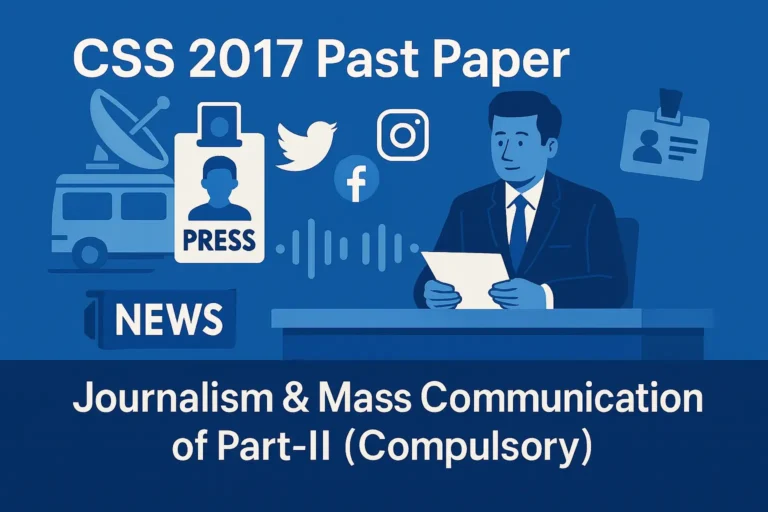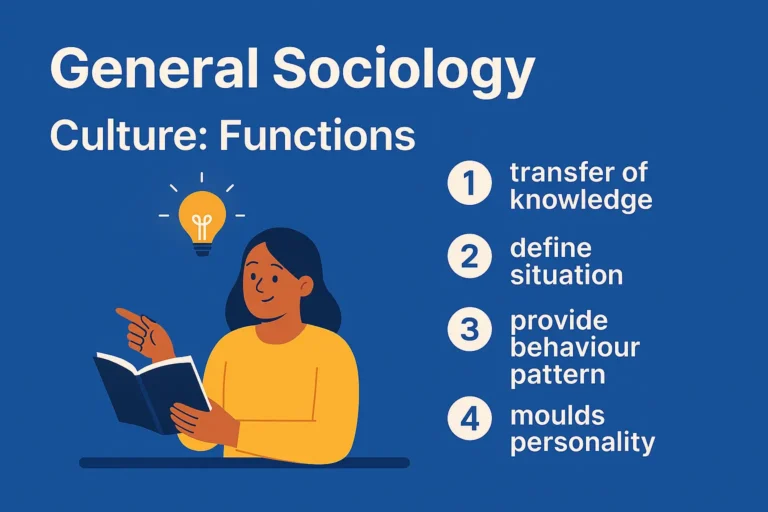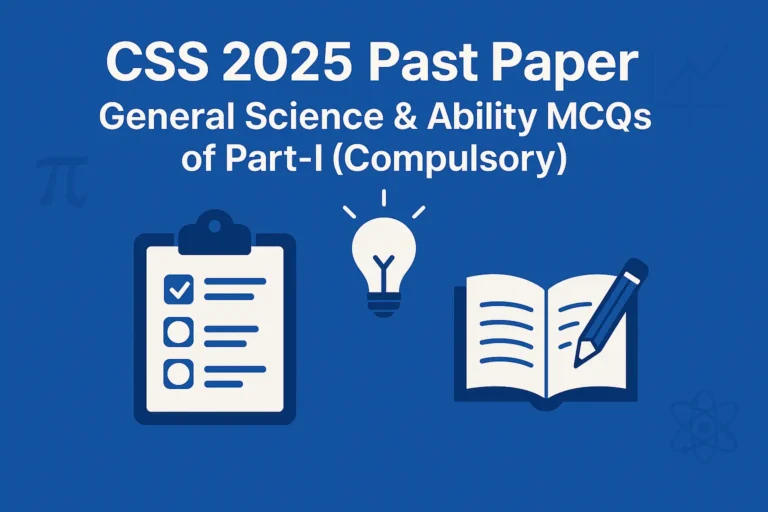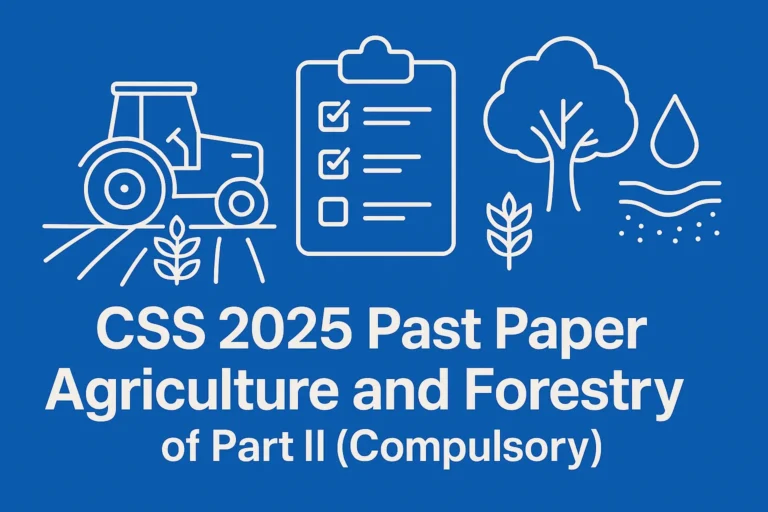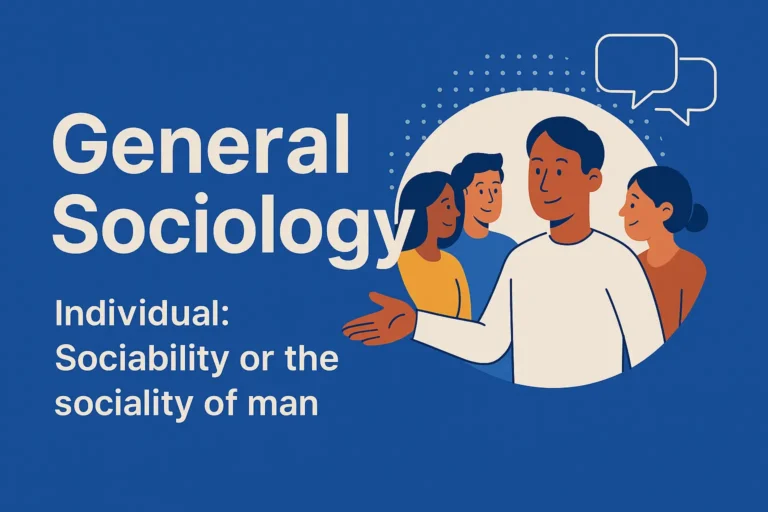CSS 2022 Solved Past Paper – Journalism & Mass Communication Part-II (Compulsory)
Below is the solution to PART-II (COMPULSORY) of the CSS 2022 Journalism & Mass Communication Paper.
Question 2
Explain the role of media as a watchdog or fourth Estate of government. Provide examples from Pakistani scenario to substantiate your stance/argument.
Introduction
Media is called the fourth pillar or “Fourth Estate” of the state, after Legislature, Executive, and Judiciary. In modern democratic systems, it plays a big role in informing people, shaping opinions, and holding those in power accountable. As a watchdog, media monitors the actions of the government, uncovers corruption, and informs the public about important issues.
Concept of Media as the Fourth Estate
The term “Fourth Estate” means that media has an important and independent role in the country just like the other three branches of government. It works outside the official state structure but still holds power through public influence. Its job is to report truth, raise voices of people, and keep democracy alive.
Role of Media as a Watchdog
Media works like a guard dog. It watches what politicians, bureaucrats, and other powerful people are doing. When they do something wrong or against public interest, media exposes it. For example:
- Investigative journalism reveals corruption.
- News channels highlight public issues like inflation or lack of clean water.
- Social media gives voice to ordinary people.
Importance of Media in Democracy
Democracy needs transparency and accountability. Media makes sure that the government remains answerable to the people. Free press allows open debates, spreads awareness, and stops misuse of power. Without media, people would not know what is happening in their own country.
Media in Pakistan: Examples of Watchdog Role
In Pakistan, media has played this watchdog role many times:
- Panama Papers Leak: Pakistani media actively reported and followed the Panama scandal which involved former PM Nawaz Sharif’s family. This reporting led to Supreme Court action and political consequences.
- Raymond Davis Case (2011): Media broke the news about a CIA contractor who killed two Pakistanis. The strong coverage forced the government to take action.
- Sugar and Wheat Scandals (2020): Media reports and investigations exposed how powerful people caused artificial shortages and made profits. Later, government had to take notice.
- Missing Persons in Balochistan: Although risky, some journalists and media outlets have covered this sensitive issue and brought attention to human rights concerns.
Challenges Media Faces in Pakistan
Even though media tries to play its watchdog role, it faces many problems:
- Censorship and pressure: Journalists are threatened or silenced when they report against powerful groups.
- Lack of access to information: Many government departments don’t share data easily.
- Media ownership issues: Big media houses may avoid reporting against their business or political allies.
- Fake news and propaganda: This harms the credibility of media and confuses the public.
Conclusion
Media is a powerful tool that helps keep the government accountable. As the Fourth Estate, it plays a critical role in any democratic society, including Pakistan. While it has made big contributions, media in Pakistan still faces many challenges. For a stronger democracy, the media should be protected, allowed to work freely, and should also act responsibly. Only then it can continue to serve as the true watchdog of the society.
Question 3
Elaborate the key assumptions of Diffusion and Innovation Theory, its strengths and weaknesses. Critically discuss its applicability from the Third-World perspective.
Introduction
Diffusion of Innovation Theory is one of the most important communication theories in development and mass media. It was introduced by Everett Rogers in 1962. This theory explains how new ideas, technologies, or products spread in a society over time. It’s very useful in understanding how people accept or reject new things.
What is Diffusion of Innovation Theory?
This theory tells us how innovation (a new idea or product) is passed from one person or group to another through communication. It shows the process of adoption — from when a person first hears about something new to when they start using it.
Key Assumptions of the Theory
- Innovation is communicated over time through specific channels.
- People adopt innovations at different speeds (some are quick, some are slow).
- Society is divided into adopter categories:
- Innovators
- Early Adopters
- Early Majority
- Late Majority
- Laggards
- Adoption happens in stages:
- Knowledge
- Persuasion
- Decision
- Implementation
- Confirmation
- Social systems and communication channels affect diffusion.
Strengths of the Theory
- Helps in understanding how change happens in society.
- Useful for planning development programs (like health or education).
- Shows how opinion leaders affect others.
- Good for marketing and advertising strategies.
- Can predict adoption patterns.
Weaknesses of the Theory
- Too technology-focused — ignores cultural and economic issues.
- Assumes that all innovation is positive — sometimes, new things are harmful.
- It works best in developed societies, where media and education levels are high.
- Top-down approach — does not always consider people’s needs or local knowledge.
- Ignores power imbalance between developed and developing nations.
Applicability in Third World Countries
In Third World or developing countries, the theory has limited success. Many innovations fail to spread because of poverty, low education, and weak infrastructure. Also, Western-based innovations might not fit local culture or needs.
For example:
- A new mobile health app might not work well in rural areas of Pakistan where people don’t have smartphones or internet.
- Agricultural technologies promoted in Africa or South Asia often fail because farmers can’t afford them or don’t trust them.
Examples from Third World (including Pakistan)
- Family Planning Campaigns: In Pakistan, mass media was used to promote family planning. Some people adopted it, but many resisted due to cultural and religious beliefs.
- Polio Vaccination Drives: Despite heavy media support, some areas showed resistance due to rumors and lack of trust.
- Mobile Banking (Easypaisa, JazzCash): This is one area where innovation spread successfully, even in villages, due to ease of use and local adaptation.
Critical Analysis
Diffusion theory assumes that all societies behave the same way, but that’s not true. In Third World countries, adoption depends more on trust, religion, poverty, and education. Also, innovations must be adapted to local culture. The theory doesn’t focus much on these issues, so its usefulness becomes limited unless modified.
Development communication experts now believe in participatory approaches where people are involved in decision-making instead of just receiving innovations.
Conclusion
Diffusion of Innovation Theory is helpful in understanding how new ideas spread, but it cannot be blindly applied to Third World countries. It needs to be adjusted to local realities. In countries like Pakistan, success depends on cultural relevance, trust, and access to resources. Development programs must focus on bottom-up approaches to make real impact.
Question 4
What is globalization? Critically examine its impact on Pakistani culture. Explain, how globalization is different from Westernization?
Introduction
Globalization is one of the most powerful forces in today’s world. It connects people, countries, and cultures across the globe. But with this connection, it also brings many changes, especially in developing countries like Pakistan. One of the major areas affected is our culture, which is now facing both opportunities and threats.
Definition of Globalization
Globalization means the increasing interaction of people, businesses, and governments worldwide. It includes the flow of goods, services, technology, information, and culture across borders. With the help of internet, media, and fast transport, the world is now like a global village.
Features of Globalization
- Free flow of information through internet and media
- International trade and business
- Spread of multinational companies
- Cultural exchange (music, fashion, food, language)
- Use of modern technology in communication and transport
Impact of Globalization on Pakistani Culture
Pakistani culture is rich in traditions, family values, religion, language, and customs. Globalization has brought many changes to this culture. Some are good, some are not.
Positive Effects
- Exposure to new ideas: People learn from other cultures and improve their knowledge.
- Women empowerment: Global media has shown role models for women, leading to more participation in jobs and education.
- Access to education: Online learning and international degrees have become more common.
- Modern lifestyle: People now enjoy better technology, fashion, and entertainment.
Negative Effects
- Cultural invasion: Western TV shows, movies, and songs have affected local traditions.
- Language shift: Young people prefer English and ignore Urdu and regional languages.
- Family system: Traditional joint family system is breaking; nuclear families are rising.
- Religious and moral values: Exposure to liberal content has weakened some religious values.
- Consumerism: People now want branded items and expensive lifestyles, even if they can’t afford.
Difference Between Globalization and Westernization
Many people confuse globalization with Westernization, but they are different.
| Globalization | Westernization |
| A global process involving all cultures | Influence of Western (mainly American/European) culture |
| Two-way exchange of culture | Mostly one-way (West influencing others) |
| Includes China, Japan, Gulf, etc. | Mainly US and Europe-based culture |
| Not always harmful | Often leads to cultural loss |
So, globalization is about worldwide connection, but Westernization is about adopting only Western values and style.
Conclusion
Globalization is not completely bad or good. It depends on how we deal with it. If we adopt only the negative sides, like blindly copying Western fashion or leaving our religion, it harms our culture. But if we use globalization to learn, grow, and share our own values, it can be helpful.
The problem in Pakistan is that we are not promoting our own culture enough. Our dramas, music, and literature can also be shared globally, but we focus more on copying others.
Question 5
Discuss the role of new technologies in Public Relations. Support your answer with suitable examples from the context of Pakistan.
Introduction
Public Relations (PR) is all about building and managing a positive image of an organization or person. In today’s fast digital world, technology has become the backbone of PR. Especially in Pakistan, PR strategies have changed a lot with the rise of the internet and social media.
What are Public Relations (PR)?
PR is the practice of managing communication between an organization and its audience. It helps in building trust, managing reputation, and handling crisis situations. PR uses media, events, press releases, and now digital platforms to reach people.
New Technologies in PR
Some of the new technologies that are widely used in modern PR include:
- Social media platforms (Facebook, Twitter, Instagram, TikTok)
- Websites and blogs
- Email marketing tools
- Data analytics and tracking tools
- Artificial Intelligence (AI) for chatbots and auto-replies
- Mobile apps for direct customer engagement
- Video conferencing and webinars
Role of New Technologies in Modern PR
- Real-time communication: PR professionals can share updates instantly through social media.
- Wider audience reach: Technology allows organizations to reach national and international audiences.
- Crisis management: In case of any negative event, quick online statements can control damage.
- Two-way communication: People can give feedback and companies can respond.
- Content creation and storytelling: Videos, infographics, and live streams improve storytelling.
- Performance tracking: PR experts can use analytics to see how well their message is reaching people.
Examples from Pakistan
- Govt. of Pakistan’s Social Media Presence: Government departments like ISPR, Ministry of Health, and Ministry of Foreign Affairs use Twitter actively for announcements and public communication.
- Political PR: Politicians like Imran Khan, Bilawal Bhutto, and Maryam Nawaz use social media to directly connect with youth and voters.
- Brand PR Campaigns: Brands like Jazz, Daraz, and Coca-Cola use social media and influencers to promote their positive image.
- Crisis Handling: During COVID-19, the government used SMS alerts, WhatsApp messages, and social media to spread awareness.
- NGOs & CSR Campaigns: Edhi Foundation and Saylani Trust use websites and online donation portals to connect with people.
Benefits of New Tech in PR
- Low cost, high impact: Digital PR is cheaper than traditional methods like TV ads.
- Fast feedback: Helps in improving campaigns quickly.
- Targeted reach: PR messages can be sent to specific age groups, regions, or interests.
- Interactive: Audiences can like, comment, and share PR content.
Challenges and Concerns
- Fake news and misinformation spread fast on social media.
- Negative comments or viral backlash can damage reputation quickly.
- Digital divide: Many people in Pakistan still don’t have access to internet or smartphones.
- Privacy concerns and data misuse by companies.
Conclusion
New technologies have completely changed the way PR works in Pakistan and around the world. With tools like social media, data analytics, and mobile apps, PR has become faster, smarter, and more powerful. But with great power comes great responsibility. PR experts must use these tools wisely to build trust, engage people, and promote positive change in society.
Question 6
Discuss the history of Development Support Communication. How ICTs (Information and Communication Technologies) transform Development Support Communication in the age of Globalization? Comment.
Introduction
Development Support Communication (DSC) plays a very important role in improving lives of people by sharing useful information about health, education, agriculture, and other areas. With the rise of Information and Communication Technologies (ICTs), DSC has become faster and more effective, especially in the modern globalized world.
What is Development Support Communication (DSC)?
DSC means using communication to support development goals. It includes spreading awareness, educating people, and encouraging positive behavior through media like radio, TV, print, and now digital tools. The aim is to help people make better decisions for their lives and communities.
History of DSC
- 1950s–60s: The concept started during early development projects in Asia, Africa, and Latin America.
Example: Radio was used to teach farmers about new crop techniques in India and Latin America. - 1970s: UNESCO and FAO supported DSC projects.
- 1980s: TV and community-based programs became common.
- 1990s–2000s: Shift towards participatory communication where people also give feedback.
- 2000s onward: Rise of ICTs like internet, mobile phones, and digital media changed everything.
Role of ICTs in Transforming DSC
ICTs include mobile phones, internet, social media, satellite, and digital apps. These tools changed the way communication works in development.
- Fast and real-time communication
- Two-way communication (people can give feedback)
- Reach to remote areas through mobile networks
- Interactive content like videos, games, infographics
- Cost-effective communication compared to print or TV
Impact of ICTs in the Age of Globalization
In the globalized world, countries are more connected. ICTs help in spreading global development ideas while also letting local voices be heard.
- Global health campaigns: Information about COVID-19, Polio, or Dengue spread quickly using mobile and internet.
- Education apps: Like Taleemabad or government’s TeleSchool during COVID-19 in Pakistan.
- E-agriculture platforms: Help farmers get weather updates, market prices, and expert advice.
- Social awareness campaigns: NGOs use social media to educate people about rights, environment, and social issues.
Examples from Developing Countries (Including Pakistan)
- Pakistan Citizens’ Portal: A mobile app launched by govt to hear public complaints and improve governance.
- Bolo Bhi and SheSkills: NGOs using online platforms for women empowerment and digital rights.
- Benazir Income Support Program (BISP): Uses SMS and data systems to reach poor families.
- Digital health awareness: Sehat Kahani app provides female doctors via mobile phones to patients in rural areas.
- Radio programs in Africa: Promote AIDS awareness and farming techniques.
Challenges
- Digital divide: Many people in villages don’t have internet or smartphones.
- Language barriers: Most ICT content is in English, not local languages.
- Misinformation: Fake news spreads fast on digital platforms.
- Lack of digital literacy: People don’t know how to use technology properly.
- Funding issues: Poor countries can’t invest much in ICT-based projects.
Conclusion
Development Support Communication has come a long way, from old-style radio messages to smart digital platforms. ICTs have made DSC more powerful, faster, and more interactive, especially in the age of globalization. But to get full benefits, governments and NGOs must work to improve access to technology, educate people, and make content in local languages. Only then, DSC can bring real positive change in the lives of common people.
Question 7
Discuss the role of Development Communication in nation building. Provide suitable examples from national and international context.
Introduction
Nation building is not just about roads and buildings. It’s about building a strong, educated, and united society. Development Communication (DevCom) plays a big role in this process. It helps spread useful messages to people, promotes social values, and supports progress in health, education, economy, and governance.
What is Development Communication?
Development Communication means using media and communication tools to spread messages that help in improving lives. It includes things like awareness campaigns, public service messages, education programs, and more. The goal is to bring positive change in society.
Importance of Development Communication in Nation Building
- Creates awareness: People learn about their rights, duties, and government policies.
- Supports social unity: Promotes peace, tolerance, and national identity.
- Spreads education: Especially about health, literacy, environment, and population control.
- Boosts participation: Encourages people to take part in national development projects.
- Fights harmful practices: Like child labor, early marriages, and extremism.
Key Areas where Development Communication Helps
- Health: Spreads awareness about diseases like COVID-19, polio, or dengue.
- Education: Campaigns like “Taleem Sab Kay Liye” promote literacy.
- Environment: Tells people to plant trees, save water, reduce pollution.
- Women Empowerment: Encourages girls’ education and equal rights.
- Disaster Management: Shares information during floods, earthquakes, etc.
National Examples (Pakistan)
- Polio Campaigns: Pakistan uses radio, TV, and SMS to spread awareness about polio vaccines.
- Ehsaas Program: Uses media to inform people about poverty relief schemes.
- Clean Green Pakistan: A government campaign using social media and TV to promote cleanliness and tree plantation.
- Zara Sochiye (Geo TV): A TV campaign that talked about issues like child marriage and education.
- FM Radio in rural areas: Spreads farming tips, weather info, and health advice.
International Examples
- India’s “Swachh Bharat Abhiyan” (Clean India Mission): Used media to spread hygiene awareness.
- UNICEF campaigns in Africa: Promoted child health and girls’ education.
- USA’s “Smokey Bear” campaign: Educated people about preventing forest fires.
- WHO’s global health messages during COVID-19 helped control panic and spread correct info.
Challenges
- Illiteracy: Many people can’t read newspapers or understand messages.
- Limited media access: In some rural areas, people don’t have TV or internet.
- Language barriers: National messages must be translated into local languages.
- Misinformation: Fake news can ruin genuine development efforts.
- Lack of planning: Sometimes campaigns are poorly managed and don’t reach the right people.
Conclusion
Development Communication is like the voice of progress. It tells people how to grow, how to stay healthy, and how to work together for a better future. In Pakistan and other countries, it has helped in health, education, and social unity. But it must be planned well, in local languages, and reach every corner of the nation. Without communication, even the best development plans can fail.
Question 8
Write notes on any TWO of the following:
a. Brief history of Media Laws in Pakistan
b. Media Conglomerates
c. Press Code of Ethics
a. Brief History of Media Laws in Pakistan
Introduction
Media laws in Pakistan have gone through many changes since independence in 1947. These laws are used to regulate print, electronic, and now digital media. Sometimes they protect freedom of press, but many times they are used to control it.
Early Years (1947–1958)
- Pakistan inherited British laws like Press and Publication Act 1918, which was strict.
- Freedom of press was limited even in early years.
Military Rule (1958–1971)
- Ayub Khan introduced Press and Publications Ordinance (PPO) 1963.
- This law allowed the government to shut down newspapers and arrest journalists.
- Media was heavily controlled.
Bhutto Era (1971–1977)
- Nationalized many media outlets like Pakistan Press International (PPI).
- Used media for political propaganda.
- Press was not fully free.
Zia-ul-Haq Era (1977–1988)
- Martial law period with strict censorship.
- Journalists were punished for criticizing the regime.
- Use of religion in media laws increased.
Democratic Era (1988–1999)
- Some relaxation, but press freedom remained limited.
- PEMRA (Pakistan Electronic Media Regulatory Authority) was later introduced.
Musharraf Era & Beyond (1999–Present)
- PEMRA Ordinance 2002 allowed private TV and radio channels.
- Boom in media industry, but PEMRA also used to control channels.
- Cyber laws were introduced later like PECA 2016 (Prevention of Electronic Crimes Act).
Conclusion
Pakistan’s media laws have moved from strict control to partial freedom, but the state still uses legal tools to limit free expression. Journalists often face pressure from both state and non-state actors.
b. Media Conglomerates
Introduction
Media conglomerates are large companies that own many types of media outlets — TV channels, newspapers, radio, websites, and even production houses. Their goal is to control media content, increase profit, and influence public opinion.
Main Features
- Horizontal integration: Owning many media platforms at same level (e.g. many TV channels).
- Vertical integration: Owning every step from production to distribution.
- Global reach: Many conglomerates operate across countries.
- High influence: Can affect politics, culture, and economy.
Examples (International)
- Walt Disney: Owns ABC, Marvel, ESPN, and many others.
- Comcast: Owns NBC and Universal Pictures.
- News Corporation: Owned by Rupert Murdoch, controls many newspapers and TV channels worldwide.
Examples (Pakistan)
- Jang Group: Owns Geo News, Daily Jang, The News, and more.
- ARY Group: Owns ARY News, ARY Digital, and food/business channels.
- Dawn Media Group: Owns Dawn News TV, Dawn newspaper, Herald magazine.
Pros
- Better funding and quality content.
- Can provide jobs and training.
- Global platform for local content.
Cons
- Too much power in few hands.
- Can spread bias or propaganda.
- Smaller media outlets struggle to survive.
- Can ignore public interest for profit.
Conclusion
Media conglomerates play a strong role in shaping public opinion. While they offer high-quality content and jobs, they also create media monopoly and limit diverse voices. Balance is needed to ensure media remains free and fair.
c. Press Code of Ethics
Introduction
The Press Code of Ethics is a set of rules and guidelines that journalists and media organizations must follow. Its main purpose is to ensure responsible, fair, and honest reporting. It helps protect the rights of individuals and maintains public trust in the media.
Key Principles
- Truth and Accuracy:
Journalists must report facts correctly. They should confirm news before publishing and avoid spreading false information. - Fairness and Impartiality:
Reporting should not be one-sided. Media must give space to all opinions and not show personal or political bias. - Respect for Privacy:
Media should not invade someone’s personal life without a strong public interest reason. - Avoid Harm:
Journalists must not publish content that can harm someone’s life, image, or mental health, especially in cases of crime, children, and victims. - No Hate Speech:
Media should not promote hate, violence, or discrimination based on religion, race, gender, or language. - Accountability:
If media makes a mistake, it should admit it and correct it quickly. - Independence:
Journalists should avoid any influence from advertisers, political parties, or owners when reporting news. - Avoid Plagiarism:
All sources must be properly credited. Copying someone else’s work is unethical.
Examples in Pakistan
- Pakistan Federal Union of Journalists (PFUJ) andCouncil of Pakistan Newspaper Editors (CPNE) have their own ethical codes.
- PEMRA Code of Conduct 2015 guides TV channels on how to report news ethically.
Conclusion
A strong press code of ethics is necessary for responsible journalism. It protects both the media and the public. In Pakistan, where media faces many pressures, following these ethical rules ensures trust, professionalism, and a better society.

